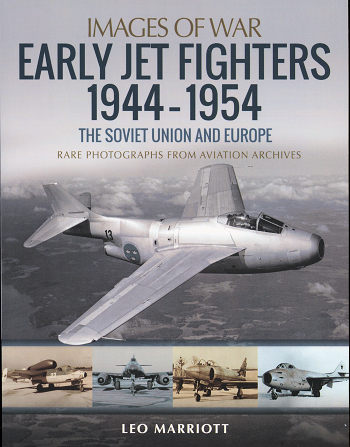 Pen
& Sword have chosen an interesting title for one of their latest books. The
early days of jet propulsion brought a great deal of promise to aircraft
designers. It also brought new challenges. Early jets were fast, but they were
also fairly fragile and consumed fuel at a fairly high rate when compared to
piston engine aircraft. This high fuel consumption plagued designers for years
and it was not surprising that so many early jets were so large, or had such
short range due to this
feature.
Pen
& Sword have chosen an interesting title for one of their latest books. The
early days of jet propulsion brought a great deal of promise to aircraft
designers. It also brought new challenges. Early jets were fast, but they were
also fairly fragile and consumed fuel at a fairly high rate when compared to
piston engine aircraft. This high fuel consumption plagued designers for years
and it was not surprising that so many early jets were so large, or had such
short range due to this
feature.
Early jets also suffered from a lack of power. In order
to get the sort of performance wanted, the aircraft either had to be small and
therefore short ranged, be large to carry fuel, which added weight and degraded
performance, or had to have at least a pair of engines. Designers were always
looking for the best trade-off to provide an aircraft that would provide the
needs of the military and to provide sales. Fortunately for most nations, either
serendipity (at least for the Russians) or improved engine design allowed early
fighters to have fairly decent performance.
Though the book only covers the first ten years, it
included a lot of aircraft that were in prototype development in 1953 and 1954.
It also includes a lot of aircraft that never really made the cut for various
reasons. The book also only covers the Soviet Union and Europe, leaving the US
and UK for other editions. A probably unrelated observation is that aside from
the Germans, all these early jets were without any sort of camouflage.
The author has divided the book into sections. After a
nice introduction, these sections are by country starting with Germany, then
the Soviet Union, France, Sweden, and finally other European nations like Italy
and Switzerland. This latter section even includes Argentina as it was Kurt Tank
who took his design worth there after the war. In each
section we are provided with a bevy of excellent photos of both prototype and
production types with the majority of the information provided in the photo
captions. Again, there are photos with which some of us are familiar as well as
those that are new to us. I personally liked the French section as they seemed
to be the most willing to experiment with things that other nations would not. If you find the subject as fascinating as do I, you
will certainly want to pick this one up.
May 2020
Copyright ModelingMadness.com. All rights reserved.
Review book courtesy of
Casemate Publishing, where you can order your copy
at this link.
If you would like your product reviewed fairly and
fairly quickly, please
contact
me or see other details in the
Note to
Contributors.
 Pen
& Sword have chosen an interesting title for one of their latest books. The
early days of jet propulsion brought a great deal of promise to aircraft
designers. It also brought new challenges. Early jets were fast, but they were
also fairly fragile and consumed fuel at a fairly high rate when compared to
piston engine aircraft. This high fuel consumption plagued designers for years
and it was not surprising that so many early jets were so large, or had such
short range due to this
feature.
Pen
& Sword have chosen an interesting title for one of their latest books. The
early days of jet propulsion brought a great deal of promise to aircraft
designers. It also brought new challenges. Early jets were fast, but they were
also fairly fragile and consumed fuel at a fairly high rate when compared to
piston engine aircraft. This high fuel consumption plagued designers for years
and it was not surprising that so many early jets were so large, or had such
short range due to this
feature.